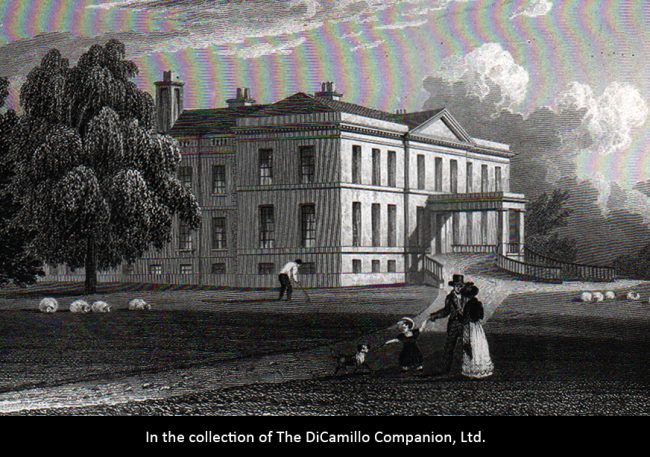
An 1829 engraving of the House from "Neale's Views of Seats"
House & Family History: Acton Park was the birthplace of the infamous George Jeffreys (1645–89), later 1st Baron Jeffreys of Wem, and best known as Judge Jeffreys or "The Hanging Judge." Sir Griffith Jeffreys rebuilt Acton Hall between 1687 and 1695, while his wife, Dame Dorothy, is notable for establishing a charity in her will that helped to found many of the first schools in Wrexham. In 1917 Acton Park was bought by Sir Bernard Oppenheimer, who opened a diamond cutting school and workshop in the grounds. The plan was to provide jobs for ex-servicemen on their return from active duty after World War I; however, Sir Bernard's death in 1921 led to the closing of the workshop. In 1921 William Aston purchased the House and grounds, with plans to convert the House into a technical school. Instead, the House became a showroom and warehouse for Aston's furniture company, while the grounds were opened to the public. In 1939 the War Office requisitioned Acton Park and Nissen huts were erected in the ground for the soldiers, while the officers put up in the House. The Royal Welsh Fusiliers, the South Wales Borderers, the Lancashire Fusiliers, and the Gurkhas were just a few of the British regiments stationed at Acton during World War II. In 1943 the U.S. Army 33rd Signals Construction Battalion and 400th Armored Field Artillery Battalion were billeted at Acton Park. The U.S. Army left the House in very poor condition, which resulted in the North Wing being demolished just after the War. By 1954 the House was virtually ruinous and a campaign was begun by Alderman Hampson to save Acton as Wrexham's museum; his efforts failed and the House was demolished in 1954.
Garden & Outbuildings: In the early 20th century Nine Acre Field and sixty acres near Rhosnesni Lane, both part of the Acton Estate, were purchased by the Borough Council. Patrick Abercrombie was commissioned to design a housing development for the 60-acre parcel, while the rest of the Estate was turned into small holdings for ex-soldiers. During the extreme rationing conditions of 1945-47 the local population plundered the Park for firewood. In the late 20th century a new housing development, along Herbert Jennings Avenue, was built over much of the Park, with the remainder of the Park saved as green space.
John Bernard (J.B.) Burke, published under the title of A Visitation of the Seats and Arms of the Noblemen and Gentlemen of Great Britain and Ireland, among other titles: Vol. II, p. 213, 1853.
John Preston (J.P.) Neale, published under the title of Views of the Seats of Noblemen and Gentlemen in England, Wales, Scotland, and Ireland, among other titles: 2.S. Vol. V, 1829.
House Listed: Demolished
Park Listed: Not Listed
Current Seat / Home of: Part of the grounds are owned by Wrexham government and open as a public park.
Past Seat / Home of: George Jeffreys, later 1st Baron Jeffreys of Wem, 17th century; Sir Griffith Jeffreys, 17th century. Philip Egerton. Ellis Yonge. Sir Foster Cunliffe, 3rd Bt., 19th century. Sir Bernard Oppenheimer, early 20th century. William Aston, 20th century.
Current Ownership Type: Demolished
Primary Current Ownership Use: Demolished
House Open to Public: No
Historic Houses Member: No